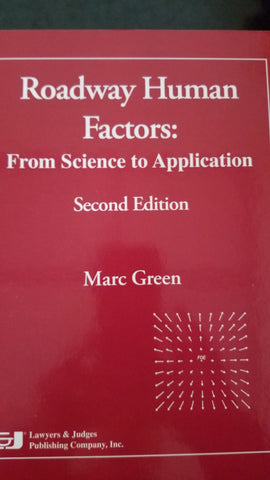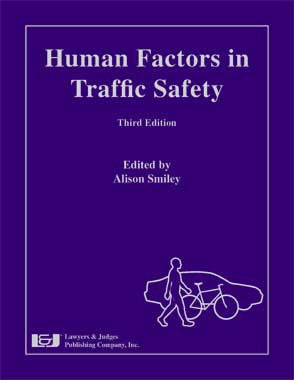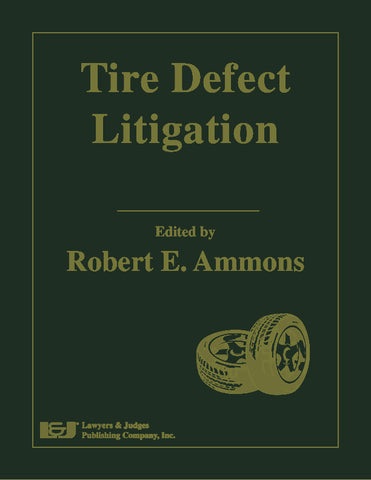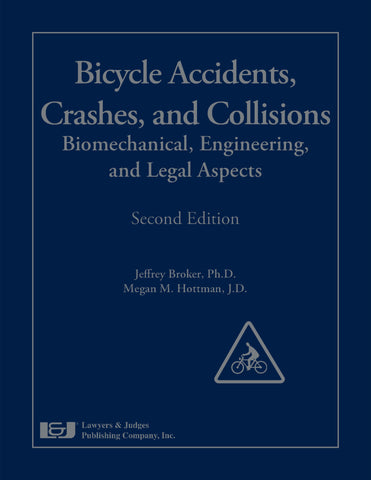
Low-Speed Automobile Accidents: Investigation and Documentation, Second Edition
- Authors: Peter H. Rast, Robert E. Stearns; Contributors: Robert Fried, Rick Robertson, Patrick J. Robins, George Ripsom
- ISBN 10: 1-930056-62-1
- ISBN 13: 978-1-930056-62-6
- Copyright Date Ed: October 1, 2003
- Pages: 144 pages
- Binding Information: Spiral-bound
-
Size: 8.5 ✕ 11 Inches (US)
Transform an uncertain case into a successful settlement!
The companion volume to: Low Speed Automobile Accidents: Accident Reconstruction and Occupant Kinematics, Dynamics and Biomechanics.
Insurance premiums are growing! Millions of dollars are spent each day to investigate fraudulent injuries and vehicle damage and to pay spurious claims resulting from low-speed automobile collisions. It is of vital importance to be able to differentiate spurious claims from legitimate ones through appropriate investigation techniques and complete and thorough documentation. Low-speed collisions are difficult to analyze because there is often little or no physical evidence and statements taken from drivers, passengers and witnesses lack depth and detail.
If proper photographs are not taken early and interviews are not conducted with knowledge of what is needed by reconstruction specialists or SIU, determination of the proper disposition of a claim is problematic at best. In this volume, you will learn how to overcome common problems and deficiencies in the investigation of low-speed automobile collisions.
In this book, you will learn to take timely photographs properly and interpret those photographs for revealing clues. You will learn how to conduct effective interviews, get the information you need, and detect when someone is being untruthful or evasive. You will know how biomechanics and occupant kinematics affect your case. In the end, you will be better equipped to investigate and document low-speed automobile collisions, reach the appropriate conclusion and arrive at a fair and just disposition of your case.
TOPICS INCLUDE
- Knowing fraud when you see it
- Photographing vehicles and vehicle damage
- Statements, interviews, memory and deception
- The importance of eyewitness evidence
- Digital photography versus film photography
- Using statements and photographs
- Case studies in fraud detection
This book is also available as an E-book. Click here to purchase and download:
Table of Contents
1. Collision Fraud is Everyone's Problem
2. Fraud Is Older than Dirt--And It Just Can't Be Swept Aside
2.1 A Historical Review
2.2 The Age of the Automobile Brings New Opportunity
2.3 The Public Thinks Insurance Companies Are Fair Game
2.4 Law Enforcement and the Courts Aren't Much Help
2.5 Knowledge Is Power
3. Knowing Fraud When You See It--"Something Smells Really Fishy Here!"
3.1 Irregularities in the Claimant
3.2 Unusual Circumstances
3.3 Vehicle Identification Irregularities
3.4 Suspicious Vehicle Damage
3.5 Suspicious Bodily Injuries and Claims
3.6 Problems with Employment
4. Photographing Vehicles and Vehicle Damage
4.1 Camera Equipment
A. 35mm SLR cameras
B. Advance Photographic System (APS) cameras
C. Point-and-shoot cameras
D. Polaroid cameras
E. Digital cameras
F. Legal considerations pertaining to digital photography
G. Film
H. Additional equipment
4.2 How and What to Photograph
A. Some common errors
B. Identifying the vehicle
C. Identifying the beginning and end of the roll of film
D. On-center and corner photographs
E. Examples of on-center and corner photographs
F. Photographing exterior damage
G. Examples of exterior damage photographs
H. Bumper photographs
I. Photographing interiors
J. Examples of interior photographs
K. Other pertinent photographs
L. Mounting and protecting your photographs
M. Copies and enlargements
N. Printing digital images--Special considerations
4.3 Summary
5. Digital Photography versus Film Photography
6. Statements, Interviews, Memory and Deception
6.1 Purpose of an Interview
6.2 Problems with Witnesses and Statements
A. Memory
B. False memories
C. What witnesses see
D. Perception
E. Physiology
F. Age
G. Language and culture
6.3 Planning the Interview
A. Reviewing photographs
B. Background information
C. Interview setting and procedures
6.4 Basic Principles
6.5 The Interview
A. Setting up the interview
B. The opening statement
C. Background information
D. What information do you need to gather in the interview?
E. Biomechanical questions
F. Information guide
6.6 "Must Have" Information
6.7 Deception
A. Overview
B. Slips of the tongue
C. Pauses
D. Mistakes in speaking
E. Direct versus indirect responses
F. Delayed responses
G. Masking behaviors
H. Repeating or responding with a question
I. Innocuous admissions
J. Inappropriate laughter
K. Qualified responses
L. Interpreting deceptive clues
6.8 Summary and Conclusions
7. The Importance of Eyewitness Evidence in Low-Speed Collisions
7.1 Limitations of Human Evidence
7.2 Evidence and Truth
7.3 The Frailty of Human Evidence
A. What we see and hear are products of our minds, not of our eyes and ears
B. People are very poor judges of vehicle distances and speeds
C. Eyewitnesses consistently overestimate the time duration of events
D. Human memory is not like a recording device
E. Memory is autobiographical in nature
F. Our memories can become distorted
G. Memory is not stable over time
H. People are overconfident in their recollections
I. Juries place more trust in eyewitness evidence than is justified
J. Emotion facilitates improved memory for central events but poorer memory for peripheral events
7.4 Conclusions
8. Occupant Kinematics--"Your Head Hit What?"
8.1 Newton's First Law of Motion--The Foundation of Occupant Kinematics
8.2 Occupant Kinematics in Low Sp-ed Collisions
8.3 Applying Newton's First Law of Motion--Three Rules for Analysis
8.4 Seat Rebound
8.5 Case Studies
A. The case of the rocket-powered delivery truck
B. Your head hit what?
C. The case of the severe sideswipe
8.6 Conclusion and Review
9. Injury Biomechanics in Low-Speed Collisions
9.1 Introduction
9.2 The Study of Biomechanics
9.3 Anatomical Considerations in Injury Assessment
9.4 The Vertebral or Spinal Column
9.5 Cervical or Neck Region
9.6 Mechanical Considerations
9.7 Biomechanical Analysis
9.8 Areas of Special Consideration
A. The brain
B. Shoulder injuries <br>C. Thoracic outlet syndrome <brD. Knee injuries
E. Carpal tunnel syndrome
F. Temporomandibular joint disorder
10. Using Statements and Photographs
10.1 Target Vehicle Stopped, Bullet Vehicle Braking
A. Estimating impact speed
B. Estimating target vehicle speed change
10.2 Target Vehicle Stopped, Bullet Vehicle Stopped, Bullet Vehicle Moves Forward under Idle Acceleration
10.3 Target Vehicle Stopped, Bullet Vehicle Stopped, Bullet Vehicle Moves Forward under Normal Acceleration
10.4 Two Stopped Vehicles--First Stopped Vehicle Is Struck in the Rear and Pushed into the Vehicle Ahead
10.5 Both Vehicles Moving before Collision
10.6 Bringing Photographs into the Analysis
11. Case Studies in Fraud Detection
11.1 Lights! Camera! Action!
11.2 Information--The Key to Fighting Fraud
11.3 Making the Best of a Bad Situation
11.4 A Little Here, a Little There--Pretty Soon It Adds Up to Real Money
11.5 A Little Larceny on the Side
11.6 Back to the Future
12. Motor Vehicle Event Data Recorder Systems
Appendices
A. Idling Acceleration Factors for Calculation of Impact Speeds in Low-Speed, Rear-End Collision Tests conducted by Peter Rast and Robert Stearns
B. Acceleration Factors and Maximum Speeds under Conditions of Idle Acceleration
C. "Must Have" Information
D. Red Flag Indicators of Accident Fraud
E. Research Findings--Low-Speed Collisions




